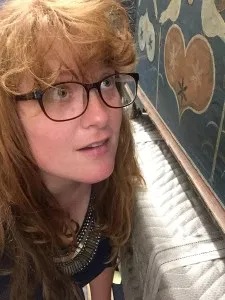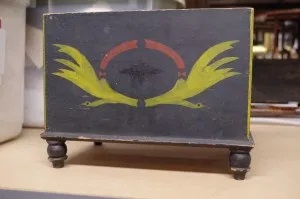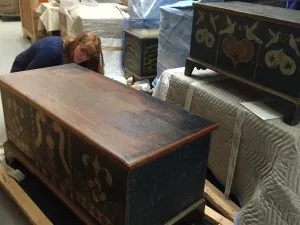Summer Research Report: Sarah Thomas
Scholars of decorative arts and material culture frequently study furniture, but few actually build it for themselves. This just happens to be one of the many skills Sarah Thomas, the recipient of a 2015 Decorative Arts Trust Summer Research Grant, brings to her dissertation project.

Sarah Thomas, PhD candidate at William and Mary, was a 2015 recipient of a Decorative Arts Trust Summer Research Grant.
A PhD candidate in history at the College of William and Mary, Sarah earned a Bachelor’s degree in history and Jefferson Studies from the same alma mater before achieving a Master’s degree in architectural history from the University of Virginia. Long a student of material culture, Sarah seeks to unite the fields of architectural history, curatorial connoisseurship, and woodworking to paint a fuller picture of an object’s role in a rural Virginian’s daily life. She argues that few professionals in these fields, “fully consider the buildings where this furniture existed and the implications of these spaces,” and whereas “dealers or curators study intricate details of period furniture for attribution or valuation… they usually end their inquiries there.”
During the summer of 2015, Sarah travelled through Shenandoah County to document extant buildings in Shenandoah county and as well as to collections in Virginia and New York City to make inroads in surveying decorative arts associated with these families and structures. She visited the Virginia Museum of Fine Arts in Richmond, the Museum of the Shenandoah Valley in Winchester, and Jeffrey S. Evans & Associates Auctions in Mt. Crawford to study important objects, focusing on chests and boxes from known and documented makers, as well as a few unattributed objects with links to Shenandoah County.
“Although chests painted by Spitler in the late-18th-century Shenandoah County are popular among collectors and curators,” she told us in her report, “We know little about the construction of these pieces. One of my goals this past summer was to closely examine construction details of chests in museum collections. While I plan to study more Spitler pieces, I have discerned several patterns that provide tantalizing clues to the maker(s) of his decorated chests. I compared features such as wedged dovetails, the prevalence of unnecessary wooden pins, and similar hardware to the work of other Shenandoah County joiners and cabinetmakers.

A Jacob Stirewalt box at the Museum of the Shenandoah Valley, photo courtesy of Sarah Thomas.
The examination of Spitler’s highly decorated chests, however, was just one component of Ms. Thomas’ summer research. “Most, if not all, of Shenandoah County furniture makers were part-time joiners primarily employed in agriculture and, at times, the church. At the Museum of the Shenandoah Valley, I examined a box with curator Nick Powers that was probably constructed by Jacob Stirewalt, a preacher and farmer. Studying the simply constructed, though thoughtfully decorated boxes at the MSV piqued my interest in this artisan. I will continue to research him through the extensive document collections left by the Henkel family, as well as Stirewalt’s own writings and records, and the boxes attributed to him.”

Sarah examines a chest by Johannes Spitler in the storage facility of the American Folk Art Museum in New York City.
Trust members will get to hear more about Sarah’s fascinating project next year, as she will present her research in conjunction with the Fall 2016 Symposium in Winchester. We anxiously await the opportunity to learn more about these talented artisans working in the Valley of Virginia.
Sarah added, “I am grateful for the generous funding from the Trust that made these essential research trips possible.” Summer research grants such Sarah’s are awarded each year to graduate students working on a Master’s thesis of PhD dissertation in a field related to the decorative arts. Applications can be downloaded from the Trust’s website, and submitted via email or online, and are due by April 30 each year. Questions may be directed to the Trust by phone or email.
About The Decorative Arts Trust Bulletin
Formerly known as the "blog,” the Bulletin features new research and scholarship, travelogues, book reviews, and museum and gallery exhibitions. The Bulletin complements The Magazine of the Decorative Arts Trust, our biannual members publication.







